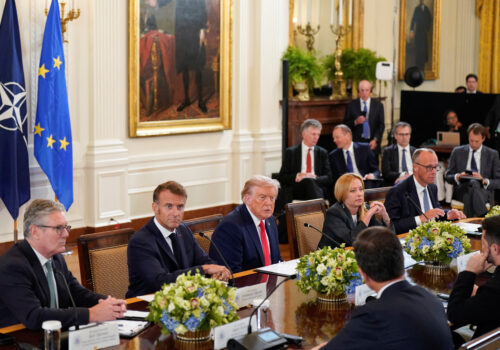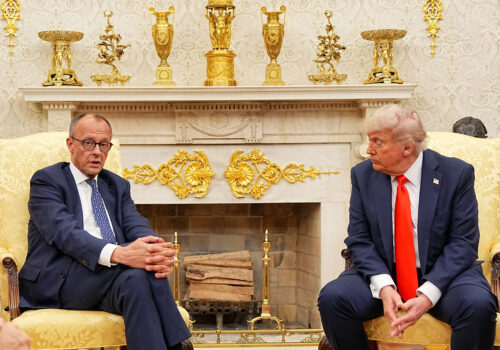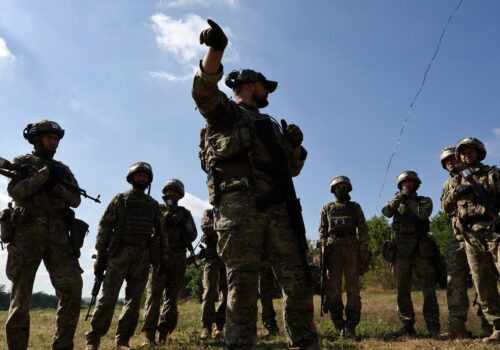Germany wants to double its defense spending. Where should the money go?
German Chancellor Friedrich Merz has pledged to revitalize Germany’s military. Among other efforts, in June, Berlin announced plans to spend nearly €650 billion over the next five years—more than double its current military spending—to hit NATO’s spending target of 3.5 percent of gross domestic product (GDP) on core defense requirements and transform the Bundeswehr into Europe’s strongest military.
This investment is welcome news. But this shift in German defense spending is a reminder of Germany’s deeply problematic and decades-long underinvestment in its defense.
For years, Germany’s defense capabilities were flashing red. It was only in 2024 that Germany hit NATO’s past spending target of 2 percent of GDP, which the Alliance agreed to in 2014. This was the first time Germany had spent 2 percent of its GDP on defense since 1991. As a result of paltry spending, German land forces stand at around 50 percent readiness. Compounding the problem are a maintenance backlog worth billions of euros and a shortfall of about twenty thousand troops—a gap likely to grow given new NATO force commitments. As it stands, Berlin lacks the personnel or the equipment to stand up the ten brigades by 2030 that it promised to NATO’s planners in 2021. Its celebrated Lithuania brigade is struggling to deploy to a friendly next-door neighbor. Earlier this year, Johann Wadephul, who is now Germany’s foreign minister, lamented that the military “has nothing at all” when it comes to drones.
All of this is happening at a time when Germany’s strategic calculus must confront both a revisionist Russia waging a genocidal war against its neighbor—and against Europe’s security order—and an increasingly disinterested United States, on which Germany based its security for the past seven decades. In short, Germany’s defense readiness needs help, and fast.
So, what should be the priority? This was a question we posed to the Atlantic Council’s Germany and defense experts, who provide ample ideas on how Germany should allocate its newfound piles of euros.
But beyond projects such as revitalizing its land, air, and naval forces, developing drone capabilities, and aiding Ukraine, what Germany needs is more than just money. If Berlin is to reassure itself, its European partners, and the United States of its newfound seriousness on defense, Germany’s spending must be as strategic as it is sizable. By choosing the right priorities, Merz could mark a real turning point, ingraining a new psyche in Germany’s strategic outlook. Below, our experts lay out the areas where Merz and his team should start.
–Jörn Fleck is the senior director of the Atlantic Council’s Europe Center.
—James Batchik is an associate director with the Atlantic Council’s Europe Center.
–Jack Muldoon, a young global professional with the Europe Center, supported the research for this project.
Essays
Germany must be prepared to operate in and beyond Europe
As Germany undertakes an unprecedented post-Cold War surge in defense spending, it is poised to emerge as a, if not the, top military power in Europe. For that capacity to deliver the greatest value to transatlantic security, particularly its cornerstone, NATO, Germany’s armed forces must be configured to address the full spectrum of challenges emanating not just from Europe, but from around the world.
To meet that requirement, one should recall an admonition credited to General John J. Pershing: “logistics wins wars.” Germany will require a regularly exercised capacity to rapidly surge and robustly sustain significant forces to NATO’s eastern frontiers amid high-intensity conflict. Progress is being made. For example, Germany is actively fulfilling a commitment to station a full brigade in Lithuania by 2027. But that progress cannot be taken for granted in a nation that recently would have struggled to deploy a single combat-ready brigade to Central and Eastern Europe.
As a leading European military power, Germany must also increase its capacity to operate beyond the continent, particularly in collaboration with the United States. It must be capable, for example, of deploying and sustaining the appropriate and commensurate naval, air, and ground forces to the Indo-Pacific as part of a transatlantic response to the challenges emanating in and from that region. Threats to transatlantic interests are increasingly coming from outside of NATO’s traditional area of operations. Developing logistical capabilities and adopting a mindset that recognizes this will be key to sustaining the United States’ commitment to European security.
—Ian Brzezinski is a senior fellow at the Atlantic Council and a former US deputy assistant secretary of defense for Europe and NATO policy.
Germany should prioritize integrated air and missile defense
As Europe’s largest economy, Germany has the opportunity to make significant contributions to European security through its promise to double defense spending over the next four years. As part of this new defense spending, Germany should prioritize integrated air and missile defense (IAMD) capabilities. IAMD is a capability that the United States may look to draw down in Europe over the coming years, and it is one that NATO has identified as a priority based on defense plans adopted at the 2023 Vilnius summit.
Specifically, Germany could boost financing and capabilities for the European Sky Shield Initiative, a project aimed at building a ground-based integrated European air defense system that was originally proposed by then Chancellor Olaf Scholz in 2022. Within this architecture (now backed by more than twenty participating European nations), Germany should look to procure European long-range capabilities that the US-made Patriot system currently provides.
—Torrey Taussig is the director of and a senior fellow at the Transatlantic Security Initiative in the Atlantic Council’s Scowcroft Center for Strategy and Security. Previously, Taussig was a director for European affairs on the National Security Council.
Beyond money, Germany’s military needs manpower, procurement reform, and innovation
Germany has taken major steps forward to boost its defense spending, but the country’s military buildup still faces a broad range of needs. The wars in Ukraine and the Middle East underscore three hard military priorities: strengthening immediate combat readiness through investments in ammunition stockpiles, spare parts, and rapidly deployable small drones; developing effective counter-drone capabilities and a robust, layered air-defense system; and putting long-range precision-strike systems in place.
But money and matériel alone don’t guarantee security. For Germany’s increased defense budget to translate into real capability improvements, three enabling factors are vital. First, manpower. Merz has declared his intention to build the strongest conventional army in Europe. But recruiting and retaining the soldiers needed to make this a reality will demand new approaches and political will. The political debate on this issue is just getting started.
Procurement reform is another important factor. The new Bundeswehr Planning and Procurement Acceleration Act, which would expedite procurement for the military, for example by raising threshold levels for simplified and direct procurement, is a welcome advance, but effective implementation is essential. The proposal has been agreed by the cabinet and is expected to be passed in the Bundestag in September. There is also a strategic opportunity for defense innovation. Germany’s defense-tech startup sector is expanding rapidly, and targeted investment here could serve a double purpose: strengthening national security while building an innovative defense industrial base. Done right, increased defense spending can become a driver of readiness, technological leadership, and economic growth.
Finally, Germany must embed these priorities in a European framework. This can increase cost-effectiveness, amplify impact, and strengthen Europe’s defense posture. This way, Berlin’s defense investments would serve both national security and the collective strength of the European Union (EU).
—Roderick Kefferpütz is a nonresident senior fellow at the Atlantic Council’s Europe Center and the director of the Heinrich-Böll-Stiftung European Union office in Brussels. The opinions expressed are those of the author and do not necessarily represent the views of the Heinrich-Böll-Stiftung.
To enhance European security, Germany needs to respond to rising drone threats in the Baltic Sea region
The impact of Germany’s increased defense spending on European security will depend not only on how it rebuilds conventional firepower—through new military hardware and a larger Bundeswehr—but also on its ability to counter the asymmetric, low-intensity threats gaining ground in the Baltic Sea region.
A recent assessment by Germany’s Federal Criminal Police Office revealed that between January and March, 536 drones were detected over German military facilities and critical infrastructure. These include liquefied natural gas terminals in Stade, Wilhelmshaven, and Brunsbüttel, the naval base in Wilhelmshaven, and the US Air Base at Ramstein. Some incidents involved swarms of up to fifteen drones, and several used custom-built or military-grade platforms invisible to standard detection systems. These figures highlight a growing vulnerability in Germany’s defensive posture at home.
This same threat profile is shaping NATO’s eastern flank, where Germany’s soon-to-be forward-deployed brigade in Lithuania will face a real operational test. In July, two Russian drones crossed into Lithuania from Belarus—one unarmed, the other carrying explosives. It is not clear whether they were sent into Lithuanian territory intentionally as part of Russia’s strategy of using provocations to test allied defenses and identify vulnerabilities. Nevertheless, the incidents illustrate how unmanned systems can blur escalation thresholds, gather intelligence, and undermine readiness without triggering an immediate military response.
For Berlin, this is more than a procurement challenge—it is a credibility test. As NATO’s framework nation in Lithuania and a logistical hub for allied forces in Central and Eastern Europe, Germany must demonstrate that it can protect its troops abroad and safeguard critical infrastructure at home, all while fulfilling its formal security commitments to Lithuania. This requires accelerated investment in advanced unmanned aerial vehicles (UAVs) for persistent intelligence, surveillance, and reconnaissance (known as ISR), as well as layered counter-UAV systems capable of detecting incursions and defending both military and civilian facilities. Failing to address these capability gaps risks leaving NATO’s front line exposed and Germany’s leadership role in question.
—Justina Budginaite-Froehly, PhD, is a nonresident senior fellow with the Atlantic Council’s Europe Center and Transatlantic Security Initiative within the Scowcroft Center for Strategy and Security.
Modernization is the Luftwaffe’s top priority
The German Air Force, or Luftwaffe, is well positioned to convert increased defense spending into a modernized and relevant fighting force for the decades to come. Historically known for low aircraft readiness rates, the Luftwaffe must prioritize air power investments to prove it does not intend to be a hollow force.
The Luftwaffe’s first priorities are onboarding the F-35 fighter jet in 2026 and retiring its oldest Tornado fighters. This will mark Germany’s transformation into a fifth-generation air force and demonstrate Berlin’s commitment to NATO’s nuclear deterrence mission. The Luftwaffe also intends to retire older Tornado jets designed for electronic warfare and replace them with unique Eurofighter variants.
Germany is a European trendsetter for the incorporation of unmanned Collaborative Combat Aircraft (CCA), also known as the “loyal wingman,” into its airforce, aiming to field this capability by 2029. The Germans have already signed several CCA industrial collaboration projects, and there are discussions about more. The Luftwaffe clearly seeks to obtain affordable airpower mass through CCA. Investments in autonomy and artificial intelligence (AI) will also be central to these projects.
Collaboration with France on the Future Combat Air System (FCAS), the three-nation (along with Spain) project to field a sixth-generation fighter jet with associated collaborative unmanned platforms, remains the Luftwaffe’s biggest risk. The well-publicized Franco-German disagreements over the FCAS project, fueled by an alleged French desire to take over a greater share of the program, will force Germany to reflect deeply on the political and military value of FCAS cooperation. Talks of an additional German F-35 purchase shows that the Luftwaffe may be hedging its investment strategy. Solving this dilemma will be among the top German defense priorities over the next four years.
—Andrew Bernard is a nonresident senior fellow with the Atlantic Council’s Europe Center.
Germany must reimagine its strategic doctrine and industrial base
Under Merz, Germany’s record €108.2 billion 2026 defense budget marks a historic shift, supporting a long-term Bundeswehr buildup and redefining Germany’s role in European security and NATO. In today’s disruptive security environment, Germany’s top defense priority should be to reimagine the country’s strategic doctrine and industrial base, focusing on four main areas.
First, create a mobile and scalable force by enhancing military capabilities, modernizing the Bundeswehr, boosting readiness, and expanding personnel. The 2026 budget provides for ten thousand new soldiers and two thousand civilian posts. The focus should now be on building a more technologically advanced military, which requires investments in cybersecurity, AI, and space technologies to position the country at the forefront of next-generation warfare.
Second, strengthen the defense industrial base. Germany can accomplish this by boosting domestic production capabilities, fostering innovation and cutting-edge technologies, securing stable supply chains, promoting a skilled workforce, and providing sustainable funding. The newly established “Sondervermögen,” fund, which provides for a €500 billion Infrastructure Special Budget, can be used for defense industry as well as strategic infrastructure and energy.
Third, deepen Germany’s European and transatlantic cooperation. Germany is already involved in initiatives such as the European Sky Shield, which is aimed at creating a continent-wide air defense system, as well as strategic deterrence talks with France and the United Kingdom. Such initiatives highlight Germany’s role in safeguarding sovereignty, supporting EU strategic responsibility, and reinforcing NATO cohesion.
Finally, Germany must build institutional and societal resilience to address traditional and hybrid threats, which will require enhancing comprehensive crisis management capabilities.
Above all, security and modernization should become societal priorities, extending beyond finances and new technologies to embrace a shift in mindset and public discourse. There needs to be a broad acceptance in Germany and in Europe that, in the words of German President Frank-Walter Steinmeier, “today, a badly armed Germany is a greater threat to Europe than a strongly armed Germany.” At stake is not only Germany’s credibility but the future of European and transatlantic security.
—Valbona Zeneli is a nonresident senior fellow with the Atlantic Council’s Europe Center and the Scowcroft Center for Strategy and Security.
Merz has shown that Germany understands the Russian threat to Europe
Merz is reasserting German primacy in Europe, and that’s a good thing. For far too long, Europe’s largest economy has come up with weak excuses for why it could not provide more military aid to Ukraine and ramp up defense production. Merz well understands the Russian threat to Europe, risks to the transatlantic alliance from Washington, and the economic opportunities that come from Germany taking a leading role as a European defense hub. And most importantly, he’s prepared to do something about it.
The most significant of these factors is just how brutal and expansive Russia’s war on Ukraine has been—killing thousands of civilians, deliberately launching missiles at schools—and how Moscow has extended the war into Europe in the form of hybrid attacks, including a foiled assassination plot against the CEO of Rheinmetall. This has forced many countries to wake up to what a Russian attack on a NATO country could look like. In Berlin, this has motivated the Merz government to take on greater responsibility for Europe’s defense and pursue the economic benefits of reindustrialization. Removing the debt brake was a major positive step toward unlocking domestic investment and opening Germany up to further investment and credit from both European partners and the United States.
—Andrew D’Anieri is the associate director of the Atlantic Council’s Eurasia Center. Find him on X at @andrew_danieri.
A renewed Zeitenwende must prioritize innovation, cooperation with Ukraine, and munitions
The Merz government’s €500 billion Bundeswehr plan (2025–2035) could transform the Zeitenwende, the policy seachange in defense and security policy announced by the previous German government, into a lasting military modernization. This transformation can best be pursued by tackling these three priorities.
First, a mentality shift. Investment must reflect warfare in the digital age. The German government should work with the Länder to roll back restrictive Zivilklauseln at universities, policies that limit defense-related research. New entrants such as Quantum Systems (UAVs), ARX Robotics (autonomous vehicles), and STARK (loitering munitions) thrive at the civilian-military edge. Defining dual-use projects more broadly would enable seamless innovation in biotech, AI, and cyber. Procurement must reward fast development cycles: today a new drone can be iterated in six weeks, while Bundeswehr systems have been known to take thirteen years from concept to fielding.
Second, Ukraine. Germany’s modernization efforts should deepen defense-industrial ties through joint ventures and coproduction in first-person-view drones, naval unmanned surface vehicles, electronic warfare, and command-and-control software. Ukraine produces tens of thousands of drones monthly and leads in battlefield electronic warfare—capabilities Germany lacks. German capital and contracts could scale Bundeswehr stockpiles while boosting Ukraine’s economy.
Third, munitions. Germany must help close a 155mm shell gap (NATO estimates an annual shortfall of more than two million shells). Repurposing idle automotive plants for artillery and medium-caliber rounds could boost output while preserving industrial jobs, learning from Ukraine’s ability to rapidly retool factories under fire.
—Tyson Barker is a nonresident senior fellow with the Atlantic Council’s Europe Center.
To keep the US engaged, Germany must become a leader in European defense
The era of European security dependence on the United States has permanently ended, making Germany’s future strategic choices critical for sustaining the strength of NATO. As Europe’s economic powerhouse, Germany must embrace this transformation and prioritize security capabilities that simultaneously cement Europe’s strategic autonomy and bolster the transatlantic partnership. This is no easy task.
Germany should first focus on becoming a regional leader in European defense. Its commitment to deploy 4,800 soldiers to Lithuania by 2027 should expand into permanent command structures coordinating multinational forces across NATO’s eastern flank. Depending on what comes of the negotiations for a potential cease-fire in Ukraine, Germany must also ensure it is contributing to whatever European forces may be present in or near Ukraine to enforce an eventual peace agreement. This would demonstrate to US policymakers from both parties that Europe, and Germany in particular, accepts primary regional responsibility for security, providing strategic flexibility for US forces to address Indo-Pacific challenges.
Germany should also adopt a defense industrial integration strategy that balances capability expansion with continued US cooperation. There’s an understandable desire and need for Germany’s defense industry to build its own indigenous security identity. Simultaneously, however, Germany should enhance production and cooperation through joint ventures and coordinated procurement with the United States. This cooperation would ensure that the transatlantic partners can maintain defense industrial ties that will survive political transitions.
These priorities, which are by no means exhaustive, will help transform Germany from a security consumer to a capable partner, creating structural incentives for sustained US engagement. There truly is no returning to the previous US-Germany defense paradigm. To ensure that cooperation with Germany remains strategically compelling for future US administrations across party lines, Germany must both lead on European defense and maintain transatlantic defense integration.
—Rachel Rizzo is a nonresident senior fellow with the Atlantic Council’s Europe Center.
Further reading
Tue, Aug 19, 2025
Europe needs to keep up the momentum for Ukraine after its White House show of force
New Atlanticist By Jörn Fleck, James Batchik
Among other steps, European leaders should press forward on defining what security guarantees for Ukraine look like.
Sun, Jun 8, 2025
A German leader’s D-Day lesson for Trump
Inflection Points Today By Frederick Kempe
In the Oval Office, German Chancellor Friedrich Merz delivered a message that no American should ignore.
Wed, Aug 27, 2025
When it comes to securing Ukraine, the US cannot stay on the sidelines
New Atlanticist By Ian Brzezinski
Ensuring Ukraine’s security after a peace agreement will require a deterrent force with substantial presence in the country, including forces from the United States.
Image: The Federal Chancellor in conversation with navy servicemen and women Chancellor Friedrich Merzs inaugural visit to the German Navy Frigate Bayern on the Baltic Sea , Rostock Warnemünde Mecklenburg-Western Pomerania Germany Frigate Bayern on the Baltic Sea REUTERS




